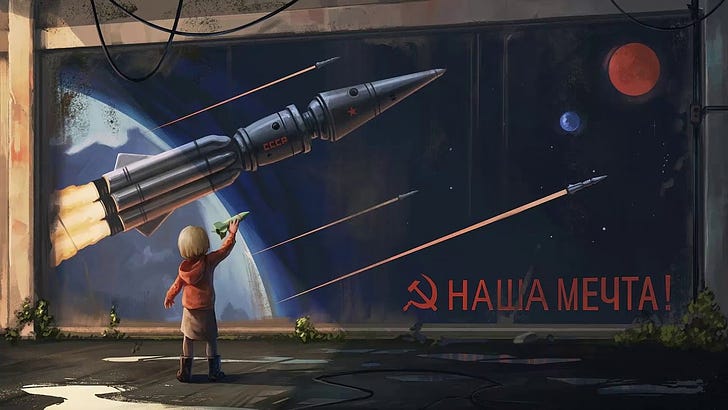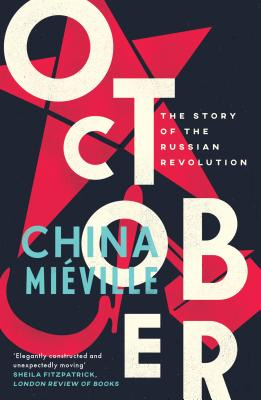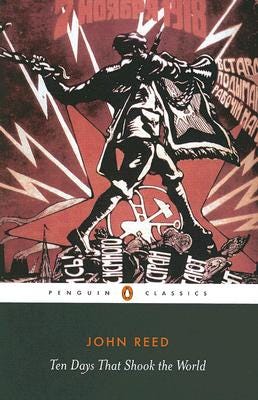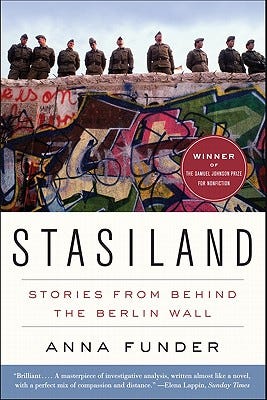Happy Russian Revolution Day!
It's been 106 years since's Russia's February Revolution — what can we learn from it?
A version of this appeared on my website for the 100th anniversary. I’ve developed different conclusions since then!
106 years ago today was the start of the February Revolution in Russia1. It was, quite possibly, the most important single event of the 20th century. Without the October Revolution, there is no Stalin. With no Stalin, it's possible that many western powers would not have seen Hitler as the lesser of two evils (the French right wing, as Hitler marched on Paris, shouted "Better Hitler than Blum!" in reference to the Democratic Socialist — and Jewish — President of France).
Without the Soviet boogeyman, there's no justification for Vietnam, for the CIA-backed coups in Chile, Guatemala, and Iran, for the American training of neofascist Central American death squads. Without those, there's no Ayatollah Khomeini, no General Pinochet, no Che Guevara and Fidel Castro.
There's no need to arm the mujahideen to fight the godless commie invaders in Afghanistan, there's no backing fundamentalist Islam as an anti-communist alternative. Without this divine cause to fight for, the founders of al-Qaeda never meet, and the towers never go down.
Without Stalin, there's no need for a show of massive force in Japan. There's no need for an atomic bomb. There is certainly no need for an arms race and a space race, no need to get to the moon by the end of the decade. Without this fear, the fear of bombs and lasers shot from satellites, there is likely no serious funding for NASA, no real space exploration.
There's no Red Scare, no McCarthy or his acolyte, Richard Nixon, there's no Truman Doctrine, no napalmed villages and cluster bombs and Khmer Rouge.
It is, of course, reductive to trace history back to a single day — events both before and after might have gone differently, and none of this was inevitable. You could make a very good argument that the actual fire started with the assassination of Archduke Franz Ferdinand, but there would be an event before that and an event before that. It was, as the poet William Joel says, always burning since the world's been turning.
But in St. Petersburg, on October 25th of 1917 (November 7th by our calendar), something impossibly immense happened. And immense things are impossible to grapple with, but until a few years ago, I realized I had no clue how the Russian Revolution went down. So I read a few books, and now it seems only proper to TL;DR them for you.
Who knows? You may be planning a revolution of your own and want pointers.
The Revolution and the Left
The history of the Russian Revolution is not taught in American schools, and when it is, it's usually misrepresented. There is a documentary on Netflix (simply called The Russian Revolution) that suggests the whole thing came down to a personal grudge that Lenin had towards the Tsar, which is just fundamentally stupid — the revolution was a mass movement resulting from centuries of oppression and hardship. Individuals were able to influence its outcomes, but no one man dictated its course. The communists, after all, do not believe in the “Great Man” theory of history.
If you're a leftist and you're interested in the history, I'd suggest picking up China Mieville's October. Mieville is a left-wing activist who also happens to be a very good fiction author, and for the 100th anniversary of the revolution, he published October as a mostly sympathetic account to the events of 1917. He does not go into the aftermath of the Revolution, whether it’s the Russian Civil War, or the purges of the 20s and 30s — Stalin is only mentioned twice in the book — but it’s a good starter for how the Soviet Union we’re all familiar with was built out of the chaos and idealism of that year.
But if you aren’t ready to commit to a book, here are some of the basics:
The revolution happened spontaneously — after decades of activism and organizing.
In 1917, there were two revolutions: the February Revolution and the October Revolution. The first deposed the tsar, whose family had ruled Russia for over 300 years. The tsar’s reign was a brutal one — massive swathes of the population lived as serfs (only a slight step up from slaves) until the 1860s, and any political unrest was met with ruthless repression.
Because of this repression, peasants and serfs grew to hate the tsar, making Russia a popular recruiting ground for left-wing radicals. Anarchists like Peter Kropotkin, Mikhail Bakunin and Leo Tolstoy became popular figures, and interest in books on socialism and Russian nihilism made authors like Nikolay Chernyshevsky and Ivan Turgenev superstars.
The most important event before 1917 was the 1905 uprising. In January 1905, a mass of workers, while trying to deliver a petition to the tsar, were fired upon by tsarist troops. Up to 1000 people died, the day became known as “Bloody Sunday,” and massive social unrest followed.
The socialists were led by a rabble of charismatic men who had given names and political names — there was the fiery orator Vladimir Ulyanov (better known as Lenin), there was the bookish, charming Julius Martov, Lenin's friend and, in many ways, his opposite, and there was the eloquent, brilliant Jewish writer and theorist Lev Bronstein (better known as Leon Trotsky). The socialists formed a democratic workers councils called a soviet, of which Trotsky was perhaps the most prominent member, and began organizing mass strikes across the capital of St. Petersburg. But after a couple of years of unrest, the uprising had been effectively suppressed by the tsar, with 15,000 dead.
Many of the leaders of the revolution had to flee the country, and were demoralized by their failure to depose the tsar. In Russia, the right-wing nationalist groups that had been used to fight the socialists began attacking their favorite scapegoats, the Jews, and killed up to 4,000 people. Lenin, now in exile, said in a speech, “We of the older generation may not live to see the decisive battles of this coming revolution.”
But Russia's peasantry had been radicalized, and the repression of the 1905 uprising was not popular. Over the next decade, Russia would enter the horrific, destructive World War I, and the tsar would become increasingly isolated from his people.
In January 1917, workers in St. Petersburg went on strike in honor of the 12th anniversary of Bloody Sunday. More strikes followed, in spite of the threats of a police crackdown, and the factory bosses made a huge mistake — they locked the workers out of the factories, forcing them — all riled up! — out into the streets.
On February 23, 1917 (in the Julian Calendar — in the western Gregorian calendar, March 8th), rallies were held in honor of International Women's Day. No one planned it — but the rallies spontaneously turned into an uprising. And the soldiers who were ordered to put down the revolution, tired of war, tired of the tsar, refused, and sided with the workers. By early March, the tsar was forced to abdicate.
The February Revolution was a mass, organic uprising that took down a 300 year dynasty. But it would not have happened without literally decades of planning, failure, and death. Many who did the work of the revolution did not, as Lenin said, live to see it.
The second revolution
From February 1917 to October 1917, Russia was ruled by a provisional government. The government was thrown together hastily, and was run by popular socialist Alexander Kerensky. Kerensky was not a revolutionary in the way Lenin or Trotsky were, but he was popular, and he was willing to work with the ruling class to transition towards a political system where power was shifted from the less Democratic former government given to the soviets, which at the time, were totally open and democratic.
Side note: I’ll cop to my bias here and say that, as far as I can see, the original Soviets were basically perfect democratic organs. Literally anyone could organize a group and join them, and all arguments and opinions were given a chance. Early members of the soviets suggested that they’d even welcome the royalists and the bourgeoisie if they’d shown up, but this would never have happened, because to do this would’ve been for those groups to recognize the councils as legitimate and, in effect, to cede their already-immense power.
But Kerensky had an impossible job. The workers and radical socialists were calling for “All power to the Soviets!” while the military was threatening a coup. Lenin, whose Bolshevik faction was among the most powerful among the Revolutionaries, was also calling for an immediate end to the war, which was obviously a non-starter for the ruling class and the military brass. It was only through the power of his charisma that Kerensky was able to keep things together for so long — and eventually, the radicals grew to hate him as a man willing to compromise with the tsarists and repress dissent from his left flank, while the military started to suspect it didn't need him at all.
Eventually, a General named Kornilov attempted to overthrow the provisional government. The coup was stopped, but Kerensky lost a huge amount of support as a result: he'd been trying to compromise with the military, and the military had stabbed him in the back. During the coup attempt, Kerensky also had to arm every socialist to stop the advancing troops — which meant that the Bolsheviks were now popular and armed. Kerensky no longer had the people at his back, and he no longer had the military. His coalition had collapsed, and there was a power vacuum.
In October of 1917, the Bolsheviks seized power in an almost bloodless coup. The provisional government was dissolved, and Lenin declared the world's first ever socialist republic. What would follow was a bloody, 5 year civil war. At the end of that war, Lenin would be near death.
Worse, during the pre-revolutionary years, the Bolsheviks had been forced to fund themselves through crime, such as robberies and kidnapping. One of the men Lenin leaned on was a Georgian named Ioseb Jughashvili. Jughashvili went by the political name of Joseph Stalin, and while not particularly adept at revolutionary doctrine, was an expert at political maneuvering. In spite of Lenin’s (and nearly everyone else’s) misgivings, he emerged at Lenin's death as the most powerful man in the country. His main rival, Trotsky, had ignored him for too long, believing him to be no more than a dumb brute, and not worthy of Trotsky's time.
After the revolutions
Lenin, Trotsky, and most socialists believed that the revolution had to be global for it to work. Capitalism had to collapse. During the October Revolution, American journalist John Reed (writer of the famous October account Ten Days That Shook the World, and subject of the Warren Beatty epic Reds) reported Trotsky saying the following:
“In any case, if Europe continues to be ruled by the imperialist bourgeoisie, revolutionary Russia will inevitably be lost. There are only two alternatives; either the Russian Revolution will create a revolutionary movement in Europe, or the European powers will destroy the Russian Revolution.”
The latter is what panned out — Germany, which was the next likely domino in the global revolution, cracked down hard on its socialist movement, and government-backed paramilitaries executed many of its leaders, like the famed Rosa Luxemburg. Similar crackdowns occurred in the UK and the United States.
Worse, when the Bolsheviks had total power, they began suppressing voices on the Soviets that did not toe the Bolshevik line. So what had originally been a big tent revolution became increasingly authoritarian. There were a number of uprisings within the ranks of the revolution against the Bolsheviks, most famously the 1921 Kronstadt rebellion, in which decorated revolutionary sailors hijacked a famed warship and demanded that anarchists and moderate socialists be allowed back into the Soviets. The Red Army, led by Trotsky, crushed the rebellion. The famed Russian anarchist, Pyotr Kropotkin, had died a few weeks before the rebellion, and given what followed, the enormous crowds of anarchists and members of the anti-authoritarian left at his funerals would be the last hurrah of open dissent in the Soviet regime.
Suffice it to say: The global revolution never happened.
And unfortunately for the revolutionaries, the world’s only communist country was now led by a man who was hardly an ideological communist. Stalin was far more interested in consolidating power than he was in loftier communist aims. So instead of fomenting global revolution — which prior to the mid-20’s, had been an unquestioned goal of Marxist dogma — he instituted a policy called "Socialism in One Country." The leftists who still hoped the revolution would turn global were horrified, but Stalin’s move cracked open the door to negotiations with other governments, now that he wasn’t calling for their immediate liquidation. Had he not done this, he would not have been able to ally himself briefly with Hitler, which gave the Soviets some breathing room in their mobilization for war.
In the 1920’s and 30’s, he dedicated much of his time to turning what had once been a democratic revolution into the most thoroughly totalitarian government that had ever existed to that point. He executed hundreds of thousands of dissenters or “enemies,” and his assassins scoured the globe until they put an icepick in his rival Trotsky’s head.
Stalin also understood that the power of the early Soviet Union was weak, and that it would not withstand a major assault from external enemies, which at the time, constituted nearly every other nation on the planet. So he began a rapid industrialization program which effectively turned Russia from a mostly rural country to an industrial one in about a decade (which is insanely fast, and also resulted in the deaths of millions of people). Had he not done this, they wouldn’t have had a chance at defeating the Nazis. And it is worth noting: the USSR deserves the majority of the credit for defeating Germany. Far more Russians died in that war than in the other Allied Armies, and it was the Russians who finally marched into Berlin when Hitler shot himself in the bunker.
Soviet nostalgia
For people like myself, who identify more with anarchism than Marxism, the Russian Revolution in something to look upon in horrified wonder. Capitalism is obviously going to destroy the planet, and we need an alternative, but, well… that one ain’t it. One suspects, in retrospect, that it didn’t need to go the way it did, but its consequences were so massive that you have to take any “the Revolution was a wonderful moment” talk with a good dose of caution.
And there are people who want to go back to that! Here at the end of history, nostalgia for the Soviet era in post-Soviet states (and even in modern tankie communist circles) is very real. If you want a book on this, Anna Funder’s Stasiland is fantastic, and if you just wanna listen to commie synth music (like I’m doing right now!) try looking up “Sovietwave.”
But I personally do not know any people on the left who genuinely want to return to that era. We face a different set of problems, and while some argue that the information age means it’s time for “Fully Automated Luxury Space Communism” others see that the danger of capitalism is no longer just racism, exploitation of labor, and the slow erosion of human dignity: it’s the wholesale destruction of the planet.
Which remains a problem for the Old School communists, because modern communist systems like those in China still subscribe to the growth-based economies that are destroying the biosphere. It doesn’t matter if we’re capitalists or communists if we destroyed the planet in our attempt to get to Mars.
New futures have to be imagined, and those futures will likely be local. It will have to be people banding together to solve massive problems as a diverse group, rather than as a united monolith. The Global Socialist Revolution, dreamt of since Marx and Engels first started stirring up shit in Vienna and London, is just not coming, because we don’t all have the same needs and interests. We are products of local ecosystems, and some systems that work for say, Polynesian Islanders, won’t work for American Midwesterners.
The good news is that there are already models for what building grassroots revolutionary movements look like: You can look to the Zapatista movement in Mexico, which has been running strong for nearly 30 years, you can look to Rojava in Kurdistan, which has made it 10 years as a ecofeminist commune while fighting off the armies of ISIS, Syria, and Turkey, and you can look to the indigenous movements that are leading the fight in protecting natural resources.
None of this means that global solidarity isn’t possible — we’re in a period of resurgent mass movements. Organized labor is winning fights all across America, Black Lives Matter has breathed new life into the under-siege anti-racism movement, environmentalist groups like Extinction Rebellion are engaging in mass disruption to end the stranglehold of fossil fuels on global politics, and in the wake of the repeal of Roe v. Wade, massive networks aiding and abetting abortion have sprung up to help people in need. We can all support these causes and actively participate with them when they intersect with ours. We can exchange ideas and tactics and build stronger coalitions.
The lessons of the Russian Revolution aren’t exclusively bad: it shows us that decades of organizing can suddenly explode into moments of progress and change. It also shows us that the revolution lasts only if we never cede our power to those who say they’d be better off in charge. To quote the immortal Ursula K. Le Guin:
“You cannot buy the revolution. You cannot make the revolution. You can only be the revolution. It is in your spirit, or it is nowhere.”
I know it’s March — they use a different calendar in Russia.






